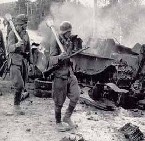Hanny
Posts: 422
Joined: 7/5/2011
Status: offline

|
quote:
ORIGINAL: randallw
Do they achieve anything? At some point in 1942 the rifle divisions are allotted a few hundred of them, but they still don't seem to kill anything. I know that they'd have trouble with anything as sturdy as a 1942 upgrade of Pz IIIs or IVs, but what about the German armored cars? Are bunches of Russians running around with metal sticks that do nothing but make noise?
In game mechanics you mean, as opposed to in real life, where it was the war best AT rifle by a wide margin. By 42 the AT rifle TOE went up by over 400% from 41 TOE.
The BS-41 tungsten-cored armor-piercing round was able to penetrate 35 to 40mm of armor at 300 meters; the side armor of the German Mark III and Mark IV tanks was only 30mm at its thickest on the flanks. The addition of another 8mm of steel armor Schurzen,( introduced to counter the Russian AT rifle and its effects on armour, von Mellenthin complained after the war, “The Russian and his antitank weapon are inseparable; sometimes it seemed as if every infantryman carried his own antitank rifle.”, he was almost right, 1.5 million in use by 44, and Guerdian stated, “The ‘aprons’ were sheets of armor plating which were hung loose about the flanks and rear end of the Panzer III and Panzer IV and the assault guns; they were intended to deflect or nullify the effect of the Russian infantry’s antitank weapons, which could otherwise penetrate the relatively thin, vertical body armor of those types of vehicle.”) physically separate from the hull armor, in addition to providing extra thickness, caused the 14.5mm round to expend much of its energy and begin to tumble from a nose-first attitude while penetrating this first layer. It also helped to protect the more vulnerable wheels and suspension system.
For the late war tigers etc, vision slots became the target, as the AT easily made the target blind by striking them, carius was one such victim and put out of action that way.
Sergeant Ilya Derevjanko is credited with 10 AFV kills.
The Soviet Infantry Manual noted: “If no tanks and armored vehicles are present, on orders of the antitank rifle squad leader the antitank rifles can take under fire enemy machine guns, artillery and the firing slits of bunkers and forts at a range out to 800 meters and aircraft at a range of up to 500 meters.”
Private Vassily Kovtun of the 902nd Rifle Regiment was given credit for destroying four tanks, two armored personnel carriers, and two armored cars. The big antitank rifles were also handy for reaching enemy soldiers behind cover in house-to-house street fighting. Antitank rifle ace Ivan Knjazev of the 310th Guards Rifle Regiment was credited in a Soviet report with “67 AFVs, MGs, guns and mortars.” Kovtun was also credited with knocking out 20 German machine-gun nests.
It was also highly present as a partisan weapon.
_____________________________
To strive, to seek, to find, and not to yield.
|
 Printable Version
Printable Version











 New Messages
New Messages No New Messages
No New Messages Hot Topic w/ New Messages
Hot Topic w/ New Messages Hot Topic w/o New Messages
Hot Topic w/o New Messages Locked w/ New Messages
Locked w/ New Messages Locked w/o New Messages
Locked w/o New Messages Post New Thread
Post New Thread